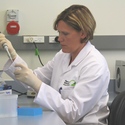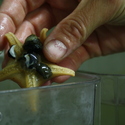Position: Professor, Department of Marine Science, University of Otago.
Field: Marine carbonate sediments1.
Professor Abby Smith leads the Carbonate Geochemistry2 and Sedimentology3 research group and lectures in the Marine Science Department at Otago University. Her field is marine carbonate sediments – in particular, what they are made of (geochemistry), how they grow (production) and how they break down (taphonomy).
Abby has always loved the sea but didn’t decide to become a scientist until she started university. Before deciding to major in biology4 and geology5 at Colby College in the USA, Abby thought about studying English and comparative religions.
When Abby was an undergraduate6, she spent a semester at the Bermuda Biological Station. She investigated the carbonate sediments that covered the limestone7 atoll where the station was based. Abby really enjoyed this work and planned to attend an oceanography institute after she finished her degree. However, a nasty fall on some ice meant that she was in a wheelchair for a number of months and so she stayed closer to home for her master’s degree. She focused on marine carbonate sediments on a beach in Maine and was based at Massachusetts Institute of Technology (MIT), the university where her engineer father works.
All children are scientists. They wonder, they try out different approaches, and they do it over and over to make sure. The great thing about being a professional scientist is that you get to act like a 2-year-old and get paid for it.
Abby’s husband is also a scientist. While he was completing his PhD8, Abby worked in a variety of roles – receptionist, secretary, medical researcher, bank assistant, science teacher and office manager. Five years later, Abby moved with her husband to New Zealand to start her own PhD with Professor Cam Nelson, a world expert in cool-water carbonates at Waikato University. Abby’s PhD focused on bryozoans, and she has been fascinated by them ever since.
Abby is now a biogeochemist9 – someone who studies the interactions of chemical, geological and biological processes in the natural environment. She has been teaching and researching in the marine science department at Otago since 1992. She really enjoys teaching and often goes out and works with schools. She supervises research students, helping them to develop the skills an independent researcher needs. She also does her own research, wondering about the how, why and what, and then devising a method to find out. She loves all the phases of research, from the wondering to the collecting to the writing.
When not busy with bryozoans, Abby enjoyed coaching her sons’ cricket teams and singing in a choir and cooking.
Nature of science
For many years, it appeared that Abby’s research into bryozoans had little practical application. She pursued her research out of intellectual curiosity. Ocean acidification10 has changed this, and some of Abby’s results from 20 years ago are now the focus of her group’s research.
Useful links
Listen to this podcast interview covering Dr Abby Smith's journey through life and science.
Read her profile on the University of Otago's website.
This article is based on information current in 2009 and 2018.
- sediments: Material that settles to the bottom of a liquid. In geology, it describes the solid fragments of inorganic or organic material that come from the weathering of rock and are carried and deposited by wind, water or ice.
- geochemistry: Study of the chemical composition of the Earth’s crust and the reactions of chemical elements in its minerals, rocks, soil, waters and atmosphere.
- sedimentology: The study of the Earth with a special interest in rocks that have formed from compacting sediments and of the processes by which they were formed.
- biology: The science of living things.
- geology: Study of the origin, history and structure of the Earth; the geological features of an area.
- undergraduate: A student who is studying for their first degree, the most common of which is called a bachelor’s degree.
- limestone: Sedimentary rocks formed mainly from the minerals calcite or dolomite. Many limestones are derived from the shells of dead marine organisms. Others are formed by chemical precipitation.
- PhD: Abbreviation of Doctor of Philosophy – a degree normally obtained after a concentrated period of research. This is the highest level of degree that involves supervision by academic staff at a university.
- biogeochemist: A scientist who studies the interactions of chemical, geological and biological processes in the natural environment.
- ocean acidification: Decrease in ocean pH due to higher levels of dissolved carbon dioxide.




